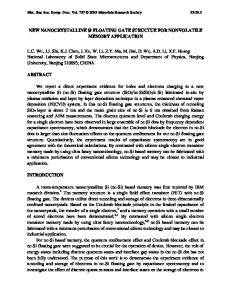Fabrication and Electrical Characterization of Metal-Silicide Nanocrystals for Nano Floating Gate Nonvolatile Memory
- PDF / 1,045,445 Bytes
- 5 Pages / 612 x 792 pts (letter) Page_size
- 75 Downloads / 301 Views
1160-H04-02
Fabrication and Electrical Characterization of Metal-Silicide Nanocrystals for Nano-Floating Gate Nonvolatile Memory Seung Jong Han1, Ki Bong Seo1, Dong Uk Lee1, Eun Kyu Kim 1*, Se-Mam Oh2 and Won-Ju Cho2 1
Quantum-Function Spinics Laboratory and Department of Physics, Hanyang University, Seoul 133-791, Korea 2 Department of Electronic Materials Engineering, Kwangwoon University, Seoul 139-701, Korea ABSTRACT We have fabricated the nano-floating gate memory with the TiSi2 and WSi2 nanocrystals embedded in the dielectrics. The TiSi2 and WSi2 nanocrystals were created by using sputtering and rapidly thermal annealing system, and then their morphologies were investigated by transmission electron microscopy. These nanocrystals have a spherical shape with an average diameter of 2-5 nm. The electrical properties of the nano-floating gate memory with TiSi2 and WSi2 nanocrystals were characterized by capacitance-voltage (C-V) hysteresis curve, memory speed and retention. The flat-band voltage shifts of the TiSi2 and WSi2 nanocrystals capacitors obtained appeared up to 4.23 V and 4.37 V, respectively. Their flat-band voltage shifts were maintained up to 1.6 V and 1 V after 1 hr. INTRODUCTION Recently, the information technology has been developed rapidly and high technologies were occurred by digital convergence. The non-volatile memory devices occupy an important position in the memory market. However, the conventional non-volatile memory devices aim to achieve higher density, lower power consumption, and faster speed operation. To solve these improvements, non-volatile memory technologies such as nano-floating gate memory, ferroelectric memory, magnetoresistive memory, and phase change memory have been reported [1]. Especially, nano-floating gate memory (NFGM) based on nanocrystals is a very attractive candidate for future non-volatile memory application [2]. The NFGM devices effectively prevent the leakage current through the tunnel oxide layer and allow a thinner tunnel oxide, smaller operating voltage, better retention property, and faster program/erase speed [3~5]. The metal nanocrystals make the deep quantum wells between control and tunnel oxide layer due to the difference of work functions [6~9]. There are serious limitations on the fabrication of metal nano-floating gate memory associated with metal diffusion problem and deformation of metal nanocrystals during thermal processes. Therefore, the metal-silicide nanocrystals have been studied for the charge storage nodes of NFGM devices. The metal-silicide nanocrystals have a larger work function, higher density of states, smaller energy perturbation, and compatibility to current device processing [10~12]. In this study, the non-volatile memory devices with metal-silicide nanocrystals embedded in SiO2 dielectric layer were fabricated by using sputtered metal-silicide thin film through post annealing. Also, the flat-band voltage shifts, the subthreshold, the threshold voltage shift, and the retention times were characterized.
EXPERIMENT The nano-floatin
Data Loading...








